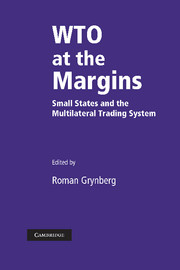Book contents
- Frontmatter
- Contents
- List of figures and appendices
- List of tables
- List of contributors
- Introduction
- Part I Theory and evidence
- Part II WTO and small economies
- Part III WTO dispute settlement
- Part IV Negotiating issues and institutional arrangements
- 17 WTO fisheries subsidies negotiations: implications for ACP fisheries access arrangements and sustainable management
- 18 Plurilateral financial standards and their regulation: the experience of small developing states
- 19 Export processing zones and the WTO Agreement on Subsidies and Countervailing Measures
- 20 The accession of Vanuatu to the WTO: lessons for the multilateral trading system
- Index
20 - The accession of Vanuatu to the WTO: lessons for the multilateral trading system
Published online by Cambridge University Press: 05 May 2010
- Frontmatter
- Contents
- List of figures and appendices
- List of tables
- List of contributors
- Introduction
- Part I Theory and evidence
- Part II WTO and small economies
- Part III WTO dispute settlement
- Part IV Negotiating issues and institutional arrangements
- 17 WTO fisheries subsidies negotiations: implications for ACP fisheries access arrangements and sustainable management
- 18 Plurilateral financial standards and their regulation: the experience of small developing states
- 19 Export processing zones and the WTO Agreement on Subsidies and Countervailing Measures
- 20 The accession of Vanuatu to the WTO: lessons for the multilateral trading system
- Index
Summary
Introduction
At present six least developed countries have formally sought accession to the World Trade Organisation (WTO). This chapter examines the accession process of Vanuatu, a small least developed country (LDC) in the Western Pacific, an experience that brings to the fore two fundamental – or perhaps over-arching – weaknesses of WTO Accession under the terms of Article XII of the Marrakesh Agreement. The process normally proceeds through two logical stages. In the first, referred to as the ‘protocol or multilateral stage’, members examine the trade regime of individual applicants, seeking clarification of, and often reforms to, the conduct of trade where they deem aspects to be in violation of existing WTO rules. Clearly, this stage of the accession process – wherein self-interested WTO members examine the WTO conformity of an applicant's trade regime, with neither the operation of any rules for the process of examination nor the applicant's having right of recourse to any review – is akin to having a complainant at a panel act as the sole panelist. It is this first and most significant of the inherent flaws in the accession process, and the ensuing abuse of power, that has resulted in the proliferation of ‘WTO-plus’ demands on new WTO applicants.
In the second stage, commonly referred to as the ‘bilateral stage’, applicants negotiate with individual WTO members on the terms of their goods offer, agricultural schedules and service sector commitments.
- Type
- Chapter
- Information
- WTO at the MarginsSmall States and the Multilateral Trading System, pp. 693 - 714Publisher: Cambridge University PressPrint publication year: 2006
- 8
- Cited by



